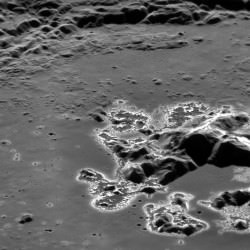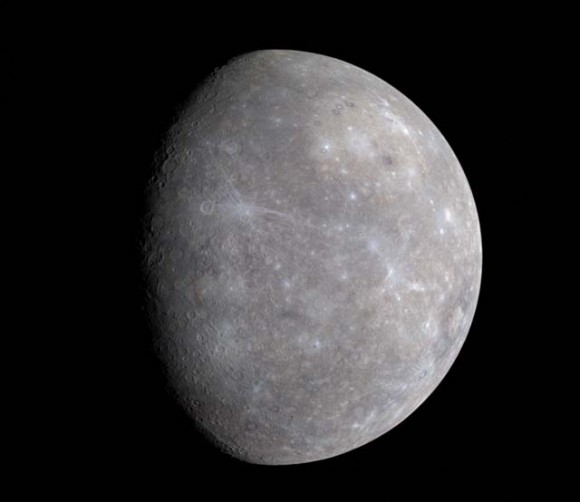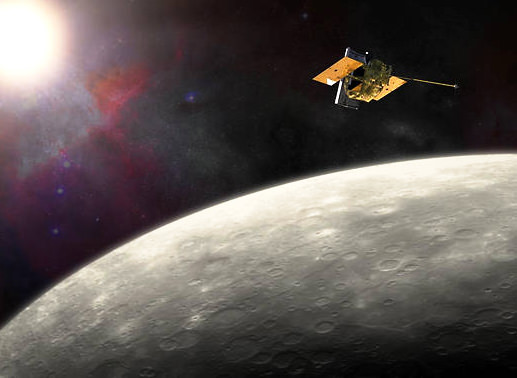For more than four years NASA’s MESSENGER spacecraft has been orbiting our solar system’s innermost planet Mercury, mapping its surface and investigating its unique geology and planetary history in unprecedented detail. But the spacecraft has run out of the fuel needed to maintain its extremely elliptical – and now quite low-altitude – orbit, and the Sun will soon set on the mission when MESSENGER makes its fatal final dive into the planet’s surface at the end of the month.
On April 30 MESSENGER will impact Mercury, falling down to its Sun-baked surface and colliding at a velocity of 3.9 kilometers per second, or about 8,700 mph. The 508-kilogram spacecraft will create a new crater on Mercury about 16 meters across.
The impact is estimated to occur at 19:25 UTC, which will be 3:25 p.m. at the John Hopkins University Applied Physics Lab in Laurel, Maryland, where the MESSENGER operations team is located. Because the spacecraft will be on the opposite side of Mercury as seen from Earth the impact site will not be in view.
Postcards from the (Inner) Edge: MESSENGER Images of Mercury

But while it’s always sad to lose a dutiful robotic explorer like MESSENGER, its end is bittersweet; the mission has been more than successful, answering many of our long-standing questions about Mercury and revealing features of the planet that nobody even knew existed. The data MESSENGER has returned to Earth – over ten terabytes of it – will be used by planetary scientists for decades in their research on the formation of Mercury as well as the Solar System as a whole.
“For the first time in history we now have real knowledge about the planet Mercury that shows it to be a fascinating world as part of our diverse solar system,” said John Grunsfeld, associate administrator for NASA’s Science Mission Directorate. “While spacecraft operations will end, we are celebrating MESSENGER as more than a successful mission. It’s the beginning of a longer journey to analyze the data that reveals all the scientific mysteries of Mercury.”
View the top ten science discoveries from MESSENGER here.
On April 6 MESSENGER used up the last vestiges of the liquid hydrazine propellant in its tanks, which it needed to make course corrections to maintain its orbit. But the tanks also hold gaseous helium as a pressurizer, and system engineers figured out how to release that gas through the complex hydrazine nozzles and keep MESSENGER in orbit for a few more weeks.

On April 24, though, even those traces of helium will be exhausted after a sixth and final orbit correction maneuver. From that point on MESSENGER will be coasting – out of fuel, out of fumes, and out of time.
“Following this last maneuver, we will finally declare MESSENGER out of propellant, as this maneuver will deplete nearly all of our remaining helium gas,” said Mission Systems Engineer Daniel O’Shaughnessy. “At that point, the spacecraft will no longer be capable of fighting the downward push of the Sun’s gravity.
“After studying the planet intently for more than four years, MESSENGER’s final act will be to leave an indelible mark on Mercury, as the spacecraft heads down to an inevitable surface impact.”
Read more: Five Mercury Secrets Revealed by MESSENGER
But MESSENGER scientists and engineers can be proud of the spacecraft that they built, which has proven itself more than capable of operating in the inherently challenging environment so close to our Sun.
“MESSENGER had to survive heating from the Sun, heating from the dayside of Mercury, and the harsh radiation environment in the inner heliosphere, and the clearest demonstration that our innovative engineers were up to the task has been the spacecraft’s longevity in one of the toughest neighborhoods in our Solar System,” said MESSENGER Principal Investigator Sean Solomon. “Moreover, all of the instruments that we selected nearly two decades ago have proven their worth and have yielded an amazing series of discoveries about the innermost planet.”

The MESSENGER (MErcury Surface, Space ENvironment, GEochemistry, and Ranging) spacecraft launched on August 3, 2004, and traveled over six and a half years before entering orbit about Mercury on March 18, 2011 – the first spacecraft ever to do so. Learn more about the mission’s many discoveries here.
The video below was released in 2013 to commemorate MESSENGER’s second year in orbit and highlights some of the missions important achievements.
Source: NASA and JHUAPL
Are you an educator? Check out some teaching materials and shareables on the MESSENGER community page here.


thanks for your service.
I have great admiration for the team for the way they’ve maximised the propellant. First using solar radiation pressure to perform course corrections en-route instead of expending fuel, now this neat trick with the helium pressurant. It’s given us so much more science from MESSENGER, and the tricks learnt will come in handy for future missions.
Well done Messenger Team. CONGRATS on a hugely successful mission.
Did Messengery map all the surface of Mercury? If not, will a second one finish the job?
Yes, MESSENGER has succeeded in mapping 100% of Mercury’s surface.
It’s amazing how man has been able to explore the Solar System & the immence beyond. While theories and hypothesis may serve their purpose, they do not make for clear and concise scientific advancement. It would better serve humanty if opinions were kept as just that-opinions and not be put out there as fact.
“At that point, the spacecraft will no longer be capable of fighting the downward push of the Sun’s gravity”.
Please explain! This statement has been used (at least) twice!!!!
According to the Messenger website, the orbit is not stable because of gravitational perturbations caused by the Sun. These act to lower the periapsis (the low point of the ellipse). Without the occasional boost, the periapsis will soon intersect the planet’s surface. “Pushed down by the Sun’s gravity” is a simplification of that.